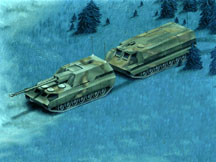- 鐵幣
- 26461 元
- 文章
- 11533 篇
- 聲望
- 11136 枚
- 上次登入
- 19-10-17
- 精華
- 175
- 註冊時間
- 05-12-25
- UID
- 215856
  
|
Crusader

The Fiscal Year 2001 Army budget request included decisions to restructure or "divest" a number of programs in order to provide some of the resources to support its transformation to achieve the ambitious deployment goals outlined in the October 1999 Army Vision. The restructured programs are the Crusader and the Future Scout and Cavalry System. The "divestitures" include Heliborne Prophet (Air), MLRS Smart Tactical Rocket (MSTAR), Stinger Block II, Command and Control Vehicle (C2V), Grizzly, Wolverine, and the Army Tactical Missile System Block IIA. Funding for these programs was reallocated to fund the Army Vision transformation strategy.
The Army restructured the Crusader program to gain improvement in indirect fire support capability and reducing the overall weight of the system while maintaining all key performance parameters (lethality and mobility). The decision to restructure the Crusader was based on affordability and its compatibility with the Army Vision. By restructuring Crusader the Army saves $11.2 billion between FY00 and FY14. The restructure strategy includes partially satisfying the Army howitzer requirement by continuing to use Paladin and LW155 howitzer platforms, reducing the number of Crusaders from 1,138 to 480, and reducing system weight to 40 tons or less to equip III Corps divisions.
The Crusader system, formerly known as Advanced Field Artillery System (AFAS), consists of an automated 155 mm self propelled howitzer (SPH) and a resupply vehicle (RSV) operated by three crew members in each vehicle. The Crusader artillery system, including its dedicated resupply vehicle, will be the Army's 21st century self-propelled howitzer and will provide artillery support to the maneuver forces on the future battlefield. The system, will utilize innovative propellant technologies to propel 155mm rounds to ranges up to 50 kilometers and will be capable of firing 10-12 rounds per minute. In addition, the Crusader will be able to fire up to eight rounds which can impact simultaneously on a target. These new features will greatly increase artillery forces' lethality and versatility and will provide a significant increase in battlefield tempo. PM Crusader, with matrix support from TACOM-ARDEC, is also helping to develop a dedicated support vehicle which will provide ammunition, propellant, fuzes and fuel to the forces in the field. Both the self-propelled howitzer and the resupply vehicle will utilize state-of-the-art robotic handling systems which will decrease the time and number of personnel needed for resupply. In addition, these systems will be capable of maintaining speed and maneuverability with forces at the front lines of the battle. TACOM-ARDEC is involved in all aspects of Crusader's development, currently in the demonstration and validation phase, through fully integrated product development teams. The Crusader self-propelled howitzer will provide soldiers with a more lethal, capable, supportable, survivable, longer range, and less manpower-intensive field artillery system which will meet the user's needs well into the 21st century.
XM2001式自行火炮和XM2002式裝甲供彈車 模擬圖
 |
|
